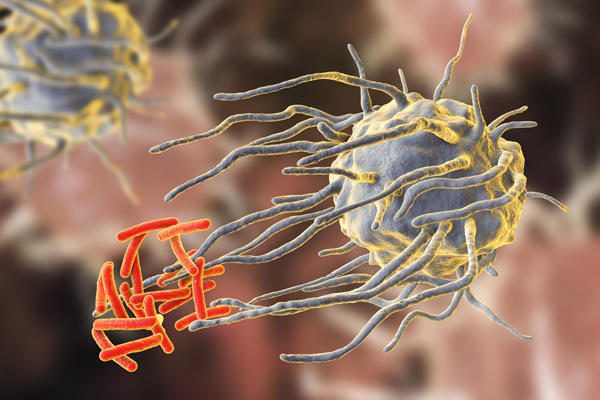Immune system
An infection can be seen as a battle between the invading pathogens and the host. Our bodies are equipped to fight off invading microbes that may cause disease. These are called our natural defences.
First line of defence
The first line of defence is non-specific and aims to stop microbes from entering the body. The skin and mucous membranes act as a physical barrier preventing penetration by microbes.
If the skin is cut then the blood produces a clot which seals the wound and prevents microbes from entering.

The surfaces of the body – the skin, digestive system, and the lining of the nose – are covered by a community of microbes called the normal body flora. They help protect the host from becoming infected with more harmful micro-organisms by acting as a physical barrier. The normal body flora colonises these linings which reduces the area available for pathogens to attach to and become established. It also means that the harmful microbes have to compete with the normal body flora for nutrients. The average human gut contains around one kilo of these good bacteria which is equivalent to one bag of sugar.
The respiratory system – the nose and passageways leading to the lungs – is lined with cells that produce sticky fluid called mucus that traps invading microbes and dust. Tiny hairs called cilia move in a wave-like motion and waft the microbes and dust particles up to the throat, where they are either coughed or sneezed out or swallowed and then passed out of the body in faeces.
The body produces several antimicrobial substances that kill or stop microbes from growing. For example the enzymes in tears and saliva break down bacteria. The stomach produces acid which destroys many of the microbes that enter the body in food and drink. Urine as it flows through the urinary system flushes microbes out of the bladder and urethra.
Second line of defence
If microbes do manage to get inside the body then the second line of defence is activated. This is also non-specific as it stops any type of microbe. Phagocytes are a type of white blood cell that move by amoeboid action. They send out pseudopodia which allows them to surround invading microbes and engulf them. Phagocytes release digestive enzymes which break down the trapped microbes before they can do any harm. This process is called phagocytosis.

Third line of defence
The third and final line of defence is the immune response. The invading microbe or pathogen is called an antigen. It is regarded as a threat by the immune system and is capable of stimulating an immune response.
Antigens are proteins that are found on the surface of the pathogen. Antigens are unique to that pathogen. The whooping cough bacterium, for example, will have different antigens on its surface from the TB bacterium.
When an antigen enters the body, the immune system produces antibodies against it. Antibodies are always Y-shaped. It is like a battle with the army (antibody) fighting off the invader (antigen). A type of white blood cell called a lymphocyte recognises the antigen as being foreign and produces antibodies that are specific to that antigen. Each antibody has a unique binding site shape which locks onto the specific shape of the antigen. The antibodies destroy the antigen (pathogen) which is then engulfed and digested by macrophages.
White blood cells can also produce chemicals called antitoxins which destroy the toxins (poisons) some bacteria produce when they have invaded the body. Tetanus, diphtheria and scarlet fever are all diseases where the bacteria secrete toxins.
Once the invading microbes have been destroyed the immune response winds down.
Once a person has had a disease they don’t normally catch it again because the body produces memory cells that are specific to that antigen. The memory cells remember the microbe which caused the disease and rapidly make the correct antibody if the body is exposed to infection again. The pathogen is quickly destroyed preventing symptoms of the disease occurring.
-
Microbes and disease
Microbes that cause disease are called pathogens. Find out which microbe is responsible for malaria!
-
Routes of transmission
Find out how you can pick up germs and pass them on to others.
-
Vaccination
Just a shot in the arm – what do vaccines do?
-
Antibiotics
Antibiotics are powerful medicines that only fight bacterial infections.






